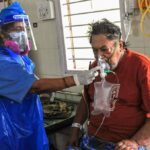The utilization of medical oxygen cylinders plays a crucial role in improving patient outcomes and recovery rates in various medical settings. Oxygen is a vital component for sustaining life, and its therapeutic administration can significantly impact the recovery and well-being of patients. In this comprehensive answer, we will explore the ways in which the utilization of medical oxygen cylinders enhances patient outcomes across different medical conditions and scenarios.
- Oxygen Therapy: Oxygen therapy involves the administration of supplemental oxygen to patients with compromised respiratory function or inadequate blood oxygen levels. By providing a higher concentration of oxygen, medical oxygen cylinders help to optimize oxygen saturation in the blood, thereby improving oxygen delivery to vital organs and tissues. This is particularly critical in conditions such as acute respiratory distress syndrome (ARDS), chronic obstructive pulmonary disease (COPD), pneumonia, asthma, and other respiratory ailments. Adequate oxygenation not only relieves symptoms like shortness of breath but also reduces the workload on the heart, enhances tissue healing, and improves overall patient comfort.
- Surgical and Anesthetic Applications: Medical oxygen cylinders are indispensable in surgical procedures and anesthetic management. During surgery, anesthesia often depresses respiratory drive and reduces spontaneous breathing. The administration of oxygen through cylinders ensures that patients receive an uninterrupted supply of oxygen, preventing hypoxia and potential complications. Oxygen cylinders are also utilized during post-operative recovery to aid patients in regaining consciousness and maintaining optimal oxygen levels.
- Emergency and Critical Care: In emergency and critical care settings, the availability and rapid deployment of medical oxygen cylinders are of utmost importance. Patients experiencing cardiac arrest, trauma, severe bleeding, shock, or other life-threatening conditions often require immediate oxygen therapy. By promptly delivering oxygen to these patients, medical professionals can stabilize their condition, prevent organ damage, and increase the likelihood of survival.
- Neonatal Care: Premature infants and newborns with respiratory distress syndrome often struggle to maintain adequate oxygenation. In neonatal intensive care units (NICUs), medical oxygen cylinders are used to deliver precise concentrations of oxygen to these fragile patients. This helps prevent or manage complications such as hypoxemia, hypoxic-ischemic encephalopathy, and other respiratory-related conditions, ultimately enhancing their chances of survival and minimizing long-term developmental issues.
- Home Care: Many patients with chronic respiratory conditions require long-term oxygen therapy to manage their conditions effectively. Medical oxygen cylinders enable these individuals to receive oxygen supplementation at home, improving their quality of life and reducing the frequency of hospitalizations. Home oxygen therapy enhances the patients’ ability to engage in daily activities, exercise, and sleep more comfortably, thereby positively impacting their overall well-being and recovery rates.
- Rehabilitation and Recovery: Oxygen therapy using medical cylinders is often prescribed during the rehabilitation phase after severe illness, surgery, or prolonged bed rest. Supplemental oxygen can improve exercise tolerance, enhance lung function, promote tissue healing, and accelerate the recovery process. It aids in the restoration of normal oxygen levels, thereby improving cardiovascular function and reducing the risk of complications.
- Management of Chronic Conditions: Medical oxygen cylinders are crucial for patients with chronic conditions such as COPD, cystic fibrosis, and pulmonary hypertension. These individuals often have compromised lung function and experience chronic hypoxemia. Supplemental oxygen therapy using medical cylinders helps maintain adequate oxygenation, reducing the symptoms of fatigue, dyspnea, and cognitive impairment. By optimizing oxygen delivery, patients can lead more active lives, experience fewer exacerbations, and improve their long-term prognosis.
It is important to note that the utilization of medical oxygen cylinders must be done under the guidance and supervision of healthcare professionals. They determine the appropriate oxygen flow rate, duration, and concentration based on individual patient needs, clinical condition, and diagnostic assessments. Regular monitoring and adjustment of oxygen therapy are essential to ensure its optimal utilization and maximize patient outcomes.

